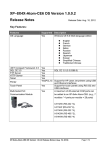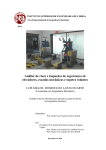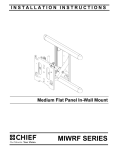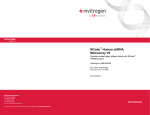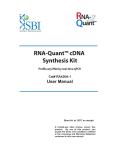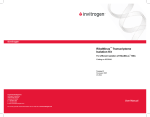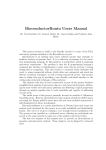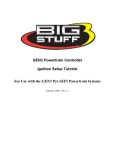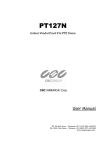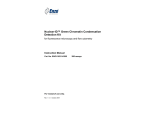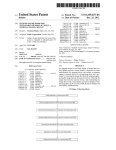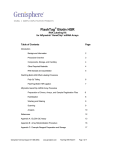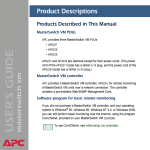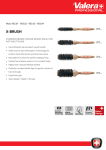Download FlexmiR™ MicroRNA Human Panel Instruction Manual
Transcript
FlexmiR™ MicroRNA Human Panel Instruction Manual for product # BG-FMIR-H20-8.0 Using LNA™ Technology from For Research Use Only. Not for use in diagnostic procedures. Version A (November 2006) 89-00002-00-166 Rev. A www.luminexcorp.com/microRNA 1 © Copyright 2006 Luminex. All rights reserved. Standard Terms and Conditions For Use of Product By opening the packaging containing this product (“Product”) or by using such Product in any manner, you are consenting and agreeing to be bound by the following terms and conditions. You are also agreeing that the following terms and conditions constitute a legally valid and binding contract that is enforceable against you. If you do not agree to all of the terms and conditions set forth below, you must promptly return the Product for a full refund prior to using it in any manner. 1. Acceptance - ALL SALES ARE SUBJECT TO AND EXPRESSLY CONDITIONED UPON THE TERMS AND CONDITIONS CONTAINED HEREIN, AND UPON BUYER’S ASSENT THERETO. NO VARIATION OF THESE TERMS AND CONDITIONS SHALL BE BINDING UPON LUMINEX CORPORATION (“LUMINEX”) UNLESS AGREED TO IN WRITING AND SIGNED BY AN AUTHORIZED REPRESENTATIVE OF LUMINEX. For purposes of this agreement, “Seller” shall mean the Luminex authorized reseller, if any, that sells the Product to Buyer. Buyer, by accepting the Product shall be deemed to have assented to the terms and conditions set forth herein, notwithstanding any terms contained in any prior or later communications from Buyer and whether or not Seller shall specifically or expressly object to any such terms. 2. Warranties – Any warranty obligations for the Product shall be exclusively provided in writing to Buyer directly by Seller. EXCEPT AS OTHERWISE SPECIFICALLY AGREED TO IN WRITING BY LUMINEX, LUMINEX MAKES NO WARRANTY WHATSOEVER REGARDING THE PRODUCT AND LUMINEX SPECIFICALLY DISCLAIMS ALL WARRANTIES, EXPRESS OR IMPLIED, INCLUDING ANY IMPLIED WARRANTY OF MERCHANTABILITY OR FITNESS FOR A PARTICULAR PURPOSE. NEITHER SELLER NOR LUMINEX SHALL IN ANY EVENT BE LIABLE FOR INCIDENTAL, CONSEQUENTIAL OR SPECIAL DAMAGES OF ANY KIND RESULTING FROM ANY USE OR FAILURE OF THE PRODUCT, EVEN IF SELLER OR LUMINEX HAS BEEN ADVISED OF THE POSSIBILITY OF SUCH DAMAGE INCLUDING, WITHOUT LIMITATION, LIABILITY FOR LOSS OF WORK IN PROGRESS, DOWN TIME, LOSS OF REVENUE OR PROFITS, FAILURE TO REALIZE SAVINGS, LOSS OF PRODUCTS OF BUYER OR OTHER USE OR ANY LIABILITY OF BUYER TO A THIRD PARTY ON ACCOUNT OF SUCH LOSS, OR FOR ANY LABOR OR ANY OTHER EXPENSE, DAMAGE OR LOSS OCCASIONED BY SUCH PRODUCT INCLUDING PERSONAL INJURY OR PROPERTY DAMAGE UNLESS SUCH PERSONAL INJURY OR PROPERTY DAMAGE IS CAUSED BY SELLER’S GROSS NEGLIGENCE. 3. Buyer’s Use of Product –Buyer agrees that no rights or licenses under Luminex’s patents shall be implied from the sale of the Product, except as expressly provided herein, and Buyer does not receive any right under Luminex’s patent rights hereunder. Buyer acknowledges that the Product is for ”Research Use Only” and has not received approval from the United States Food and Drug Administration or other federal, state or local regulatory agencies and have not been tested by Seller or Luminex for safety or efficacy in food, drug, medical device, cosmetic, commercial or any other use, unless otherwise stated in Seller’s technical specifications or material data sheets furnished to Buyer. Buyer shall not use this Product for any commercial purpose, including without limitation performance of testing services, unless expressly agreed to in writing by Luminex or as authorized by Luminex through a Luminex distributor. Buyer expressly represents and warrants to Seller that Buyer will properly test and use any Product in accordance with the practices of a reasonable person who is an expert in the field and in strict compliance with the United States Food and Drug Administration and all applicable domestic and international laws and regulations, now and hereinafter enacted. Buyer agrees that it shall only use this Product with Luminex’s standard instrumentation. BUYER HEREBY GRANTS TO LUMINEX A NONEXCLUSIVE, WORLDWIDE, UNRESTRICTED, ROYALTY-FREE, FULLY PAID-UP LICENSE, WITH THE RIGHT TO GRANT AND AUTHORIZE SUBLICENSES, UNDER ANY AND ALL PATENT RIGHTS IN INVENTIONS COMPRISING MODIFICATIONS, EXTENSIONS, OR ENHANCEMENTS MADE BY BUYER TO THE PRODUCT OR TO THE MANUFACTURE OR USE OF THE PRODUCT (”IMPROVEMENT PATENTS”), TO MAKE, HAVE MADE, USE, IMPORT, OFFER FOR SALE OR SELL ANY AND ALL PRODUCT; EXPLOIT ANY AND ALL METHODS OR PROCESSES; AND OTHERWISE EXPLOIT IMPROVEMENT PATENTS FOR ALL PURPOSES. 89-00002-00-166 Rev. A www.luminexcorp.com/microRNA 2 NOTWITHSTANDING THE FOREGOING, ”IMPROVEMENT PATENTS” SPECIFICALLY EXCLUDES PATENT CLAIMS CONCEIVED AND REDUCED TO PRACTICE BY BUYER CONSISTING OF METHODS OF SAMPLE PREPARATION, METHODS OF CONJUGATING PRODUCT TO ANALYTES, THE COMPOSITION OF MATTER OF THE SPECIFIC CHEMISTRIES OF THE ASSAYS DEVELOPED BY BUYER AND METHODS OF PERFORMING THE ASSAYS (I.E., THE PROTOCOL FOR THE ASSAY). Buyer has the responsibility and hereby expressly assumes the risk to verify the hazards and to conduct any further research necessary to learn the hazards involved in using the Product. Buyer also has the duty to warn Buyer’s customers, employees, agents, assigns, officers, successors and any auxiliary or third party personnel (such as freight handlers, etc.) of any and all risks involved in using or handling the Product. Buyer agrees to comply with instructions, if any, furnished by Seller or Luminex relating to the use of the Product and not misuse the Product in any manner. Buyer shall not reverse engineer, decompile, disassemble or modify the Product. Buyer acknowledges that Luminex retains ownership of all patents, trademarks, trade secrets and other proprietary rights relating to or residing in the Product. 4. Buyer’s Representations, Release and Indemnity - Buyer represents and warrants that it shall use the Product in accordance with Paragraph 2, ”Buyer’s Use of Product,” and that any such use of Product will not violate any law, regulation, judicial order or injunction. Buyer agrees to release, discharge, disclaim and renounce any and all claims, demands, actions, causes of action and/or suits in law or equity, now existing or hereafter arising, whether known or unknown, against Seller and Luminex, and their respective officers, directors, employees, agents, successors and assigns (collectively the ”Released Parties”), with respect to the use of the Product. Buyer agrees to indemnify and hold harmless the Released Parties from and against any suits, losses, claims, demands, liabilities, costs and expenses (including attorney, accounting, expert witness, and consulting fees) that any of the Released Parties may sustain or incur as a result of any claim against such Released Party based upon negligence, breach of warranty, strict liability in tort, contract or any other theory of law or equity arising out of, directly or indirectly, the use of the Product or by reason of Buyer’s failure to perform its obligations contained herein. Buyer shall fully cooperate with the Released Parties in the investigation and determination of the cause of any accident involving the Product which results in personal injury or property damage and shall make available to the Released Parties all statements, reports, recordings and tests made by Buyer or made available to Buyer by others. 5. Patent Disclaimer – Neither Seller nor Luminex makes any warranties as to the use of this Product based on any third party rights. Luminex and Seller specifically disclaim any implied warranties of non-infringement. Patents and Trademarks FlexmiR, xMAP, Because you want to know more, Luminex 100, Luminex 200, Luminex XYP and Luminex 100 IS are trademarks for Luminex Corporation. Exiqon and LNA are registered trademarks of Exiqon A/S, Vedbaek, Denmark. Locked Nucleic Acids are covered by patents and patent applications owned by Exiqon A/S and Prof. Imanishi. Luminex Corporation makes no representations or warranties as to the use of this Product base on third party intellectual property rights. Luminex Corporation specifically disclaims all implied warranties, including without limitation all implied warranties of merchantability, fitness for a particular purpose or non-infringement. Literature citations: Please refer to “FlexmiR™ MicroRNA Assay” whenever describing this method for publication. 89-00002-00-166 Rev. A www.luminexcorp.com/microRNA TABLE OF CONTENTS PRODUCT SUMMARY................................................................................................................................................... 5 Kit Contents............................................................................................................................................................... 5 Shipping and Storage............................................................................................................................................. 5 Additional Required Materials (user-supplied)............................................................................................. 5 Related Products...................................................................................................................................................... 6 Product Description................................................................................................................................................ 6 Definitions.................................................................................................................................................................. 7 FlexmiR MicroRNA Assay – Work Flow............................................................................................................. 7 Controls....................................................................................................................................................................... 8 Normalization microspheres......................................................................................................................... 8 Control microspheres and Capture Probes.............................................................................................. 8 Sample Analysis........................................................................................................................................................ 9 Luminex analyzer settings............................................................................................................................. 9 Sample Setup....................................................................................................................................................11 PROTOCOL.....................................................................................................................................................................12 Before starting the experiment........................................................................................................................12 Preparations during the experiment..............................................................................................................12 Experimental Procedure......................................................................................................................................13 DATA ANALYSIS............................................................................................................................................................17 Background subtraction......................................................................................................................................17 Normalization..........................................................................................................................................................17 Normalization using normalization microspheres..............................................................................17 Normalization using the FlexmiR MicroRNA Control Set . ...............................................................18 TECHNICAL SUPPORT................................................................................................................................................19 REFERENCES..................................................................................................................................................................19 89-00002-00-166 Rev. A www.luminexcorp.com/microRNA PRODUCT SUMMARY Kit Contents The FlexmiR™ MicroRNA Human Panel consists of 9 components as described in Table 1. Table 1. Kit components Amount supplied Cap color Human Pool 1 20 reactions Blue Human Pool 2 20 reactions Yellow Human Pool 3 20 reactions Green Human Pool 4 20 reactions White Human Pool 5 20 reactions Red Reporter Molecule* 36 µL Amber Hybridization Solution 1.6 mL Clear Wash Solution 45 mL Clear Nuclease Free Water 3.5 mL Clear *SAPE: streptavidin-phycoerythrin conjugate, 1 mg/mL Shipping and Storage The FlexmiR MicroRNA Human Panel is shipped on blue ice. Upon receipt, the components should be stored as individually labeled. Use properly stored reagents within three months of receipt. Additional Required Materials (user-supplied) Luminex recommends: FlexmiR™ MicroRNA Labeling Kit (product # BG-FMIR-L20) For biotin labeling of microRNAs from total RNA samples FlexmiR™ MicroRNA Control Set (product # BG-FMIR-C20) For ensuring assay integrity Biotinylated total RNA test sample Deionized water Nuclease-free PCR tubes, PCR strips or 96-well plate Heating block or thermal cycler Bath sonicator Vortex mixer Adhesive aluminum foil sealer for 96-well plates, Costar cat. #6570 Vacuum manifold (Multiscreen HTS Vacuum Manifold MSVM HTS) Vacuum pressure pump Plate shaker 96-well Thermowell P polycarbonate clear PCR plates, Costar cat.# 6509 89-00002-00-166 Rev. A www.luminexcorp.com/microRNA Sterile, nuclease-free filter barrier pipette tips 1.2 µm Millipore filter plate (Multiscreen Styrene MSBV N12XX or MSBV S1210 Luminex® 100™ or Luminex® 200™ analyzer with Luminex IS™ Software Version 2.3 or greater Related Products FlexmiR™ MicroRNA Mouse/Rat Extension Panel (product # BG-FMIR-M20-8.0) FlexmiR™ MicroRNA Labeling Kit (product # BG-FMIR-L20) FlexmiR™ MicroRNA Control Set (product # BG-FMIR-C20) Product Description The FlexmiR MicroRNA Labeling Kit labels uniformly across all RNA molecules using a simple and fast 2-part protocol (see Workflow overview, page 7). In the first part, a biotin label is attached enzymatically to the 3’-end of the RNAs molecules in the total RNA sample. This is followed by an enzyme inactivation step after which the sample is ready for hybridization. The FlexmiR MicroRNA Human Panel sensitively measures the expression of the miRBase sequence database (version 8.0) human miRNA sequences by combining xMAP® technology and Locked Nucleic Acid (LNA™) technology. The integration of these technologies allows precise detection of miRNAs without prior need for sample RNA size fractionation or amplification. Discrimination between closely related miRNA family members is achieved by the use of LNA-enhanced capture probes complementary to the mature miRNA targets. The capture probes have been Tmnormalized to hybridize optimally under the conditions described in this protocol by varying the LNA content and the length of the capture probes. Locked Nucleic Acid (LNA™) is a conformationally restricted nucleic acid analogue in which the ribose ring is ”locked” with a methylene bridge connecting the 2’-O atom with the 4’-C atom. Incorporation of LNA in one strand of a nucleic acid duplex increases the melting temperature of the duplex by 2-8° C/ LNA monomer. The general flow of the FlexmiR MicroRNA Assay allows the end-user to work on samples of total RNA to conduct the steps as follows: a biotinylation step that biotinylates the 3’ end of RNA (FlexmiR MicroRNA Labeling Kit), followed by a hybridization step where the labeled miRNA hybridizes specifically to LNA-spiked capture probes on xMAP Carboxylated Microspheres. The detection of the biotinylated miRNA is achieved by the reaction with the Reporter Molecule (SAPE) and final read of the samples in a microtiter plate on a Luminex 100 or Luminex 200 analyzer with Luminex IS Software Version 2.3 or greater versions of the software. The FlexmiR MicroRNA Human Panel includes a minimum of 97% of the annotated human sequences listed in version 8.0 of the miRBase microRNA sequence database. Please visit the Luminex microRNA resource site at www.luminexcorp.com/microRNA for information regarding the included sequences. IMPORTANT: The assay can provide quantitative results if standard material specific to a particular miRNA is obtained seperately through an oligonucleotide vendor, as standards are not provided with the panel. 89-00002-00-166 Rev. A www.luminexcorp.com/microRNA Definitions Panel A panel refers to the entire collection of assay targets performed against one unknown sample. For example, the FlexmiR MicroRNA Human Panel collates data from multiple microsphere pools (defined below) performed against an unknown sample to provide a panel of results. Pool A microsphere pool is a collection of 60-100 capture probe-bound microspheres mixed together into one vial. Since the FlexmiR MicroRNA Panels involve assay targets in excess of 100, each species-specific assay includes multiple pools to achieve coverage of the miRBase sequences. FlexmiR MicroRNA Assay - Work flow Biotin-label total RNA Hybridize to FlexmiR microspheres Detect hybridized microRNAs on the Luminex analyzer Wash Add SAPE FlexmiR MicroRNA Labeling Kit 89-00002-00-166 Rev. A FlexmiR MicroRNA Panel www.luminexcorp.com/microRNA 7 Controls Normalization Microspheres Four normalization microspheres, regions 72, 73, 74 and 76, are included in each human pool. These normalization microspheres each contain a unique LNA-capture probe specific for ubiquitous small nucleolar RNA (snoRNAs), which are expected to be present in any total RNA sample. The normalization microspheres are useful for normalizing the resulting Median Fluorescent Intensity (MFI) across all the pools for a given sample. Control Microspheres and Capture Probes Five control microspheres, regions 83, 84, 85, 86 and 87, are included in each human pool. These control microspheres each contain a unique LNA-capture probe specific to synthetic RNA oligonucleotides, which have no biological equivalents. The FlexmiR MicroRNA Control Set includes two mixtures of five synthetic RNA oligonucleotides, one mixture is biotinylated (Biotinylated Control) and the other mixture is not (Non-Biotinylated Control). Both controls are specific to the probes attached to the microspheres in regions 83-87, so only one control, either the Biotinylated Control or the Non- Biotinylated Control, may be used per well. The Biotinylated Control is provided as a stand-alone verification that the panel is performing as expected without the variable of the biotinylation labeling. It may also be used to spike into the biotin-labeled total RNA sample post-labeling to verify the integrity of the assay. The Biotinylated Control is also useful for becoming familiar with the assay or troubleshooting the assay without using precious RNA sample. The Non-Biotinylated Control is provided to spike into the unlabeled total RNA sample to verify the integrity of the labeling protocol as well as the panel protocol. It also provides a reference from which to normalize results between different samples. The Non-Biotinylated Control is also useful for normalizing results within samples, similar to the normalization microspheres, when using samples that have been enriched or samples that do not contain snoRNAs. 89-00002-00-166 Rev. A www.luminexcorp.com/microRNA Sample Analysis Luminex analyzer settings A high reporter gain setting for the Luminex analyzer is recommended to provide best results. Guidelines for modifying the gain setting and calibrating the analyzer to this setting are provided below. IMPORTANT: If the analyzer is used for other assays that utilize the low reporter gain setting, modify and calibrate the setting back to the original setting following this assay. After completing the analyzer startup procedures, which include warm-up, prime, alcohol flush, and two washes, the analyzer must be calibrated. Make sure the probe height is set for the plate type being used for calibration. TIP Tip: Steps 1-14 of the below instructions may be automated by using the calibration-control template (FMIR_Calibration_Control_Template) provided at www.luminexcorp.com/microRNA. 1.In the Maintenance tab, click on the CAL1 icon. On the Confirmation Screen that appears, click New CAL1 Target. 2.Input (or select if present in the pull-down list) the CAL1 and CAL2 lot numbers and corresponding expiration dates. For CAL1, enter (or verify) that the DD, CL1, and CL2 values on the screen for that lot match those printed on the CAL1 bottle. For CAL2, enter (or verify) that the RP1 value matches the stated RP1 Target Value on the CAL2 bottle label. When done, click OK. 3.On the Confirmation Screen use the pull-down bar at the right to select the location of CAL1 on the plate being used. 4.Click Eject/Retract to open the Luminex XYP instrument. 5.Remove CAL1 from 2° C to 8° C storage and vortex the container to ensure homogeneity. Open the bottle and invert it such that it is perpendicular to the plate and squeeze to dispense 4-5 drops from the dropper tip into the well specified on the Confirmation Screen. IMPORTANT: The number of drops used for performing calibration and controls on the Luminex analyzer depends on the type of microtiter plate used. For example, 5 drops are recommended when using a flat bottom microtiter plate. Fewer drops may be necessary for other microtiter plate types that have lower volume capacity, but be careful to ensure that sufficient reagent volume is provided to not create air in the Luminex analyzer. 6. Click Eject/Retract and then click OK to start calibration for CAL1. 7. Once CAL1 calibration has passed successfully, on the “Maintenance” tab, click on the CAL2 icon. On the Confirmation Screen that appears repeat steps 4-6 for CAL2. 8.After both CAL1 and CAL2 have passed successfully, click on the CON1 icon in the Maintenance tab. 89-00002-00-166 Rev. A www.luminexcorp.com/microRNA 9.Input (or select if present in the pull-down list) the CON1 and CON2 lot numbers and corresponding expiration dates. For CON1, enter (or verify) that the Target A1, Target B1, and Target C1 values for the 5 references are correct. For CON2, enter (or verify) that the Target A1 values are correct for the 4 references. All these values can be found on the certificates of quality that accompanied the control beads or off the FAQs page at www.luminexcorp.com. When done, click OK. 10. On the Confirmation Screen use the pull-down bar at the right to select the location of CON1 on the plate being used. 11. Click Eject/Retract to open the Luminex XYP instrument. 12. Remove CON1 from 2° C to 8° C storage and vortex the container to ensure homogeneity. Open the bottle and invert it so that it is perpendicular to the plate and squeeze to dispense 4-5 drops from the dropper tip into the well specified on the Confirmation Screen. 13. Click Eject/Retract and then click OK to start confirmation of calibration using CON1. 14. Once CON1 has passed successfully, on the Maintenance tab, click on the CON2 icon. On the Confirmation Screen that appears repeat steps 11-13 for CON2. 15.After both CON1 and CON2 have passed successfully, click on the CAL2 icon in the Maintenance tab. Click on the CAL2 icon. On the Confirmation Screen that appears, click New CAL2 Target. 16.In the Update CAL Targets dialog box, set up a new CAL2 lot using the CAL2 lot number from the bottle plus a designator, such as “A1234-high”. Calculate the new RP1 Target Value by multiplying the RP1 target value provided on the label of the CAL2 bottle by 4.55 (e.g. 3832 x 4.55 = 17436). Enter this calculated value as the new RP1 Target Value and click OK. This increases the reporter gain setting. IMPORTANT: After the assay is run, the machine will require recalibration back to the original CAL2 lot number RP1 Target Value to lower the reporter gain to the original setting. 17.On the Confirmation Screen use the pull-down list at the right to select the location of CAL2 on the plate being used. 18. Click Eject/Retract to open the Luminex XYP instrument. 19.Remove CAL2 from 2° C to 8° C storage and vortex the container to ensure homogeneity. Open the bottle and invert it such that it is perpendicular to the plate and squeeze to dispense 4-5 drops from the dropper tip into the well specified on the Confirmation Screen. 20.Click Eject/Retract and then click OK to start high reporter gain setting calibration using CAL2. 21.After calibration is complete, clean the system by clicking Wash on the Maintenance Tab. Make sure the reservoir has deionized water in it before washing. Repeat for a total of 4 washes. 89-00002-00-166 Rev. A www.luminexcorp.com/microRNA 10 Sample Setup Prior to running the sample analysis, it is important that the Luminex analyzer is loaded with the appropriate template files. Software templates are available for use with the Luminex IS Software Version 2.3 at www.luminexcorp.com/microRNA. There are five templates to download, one for each pool of microspheres. To set up the assay, create a New Multi-Batch under the File menu as described in the Luminex IS Software Manual for Version 2.3/Procedures/Batch Setup Procedures/ Create a Multi-Batch. IMPORTANT: A background control, such as nuclease-free water treated in same manner as sample, is recommended for each microsphere pool to use in determining background MFI for each pool. Also, each template begins with 2 wash cycles using deionized water from the XYP analyzer reservoir. If not using the provided templates, be sure to include 2 wash cycles between each different microsphere pool to ensure best results. When using the Luminex IS software templates, group the samples such that each microsphere pool is run together. For example: To perform the entire Human Panel, which consists of five microsphere pools or human pools, for five total RNA samples, where: Key P1 Description IS Template for Human Pool 1 P2 IS Template for Human Pool 2 P3 IS Template for Human Pool 3 P4 IS Template for Human Pool 4 P5 IS Template for Human Pool 5 Sx Sample number, for example: S1=Sample 1 * Indicates the analyzer will perform 2 wash cycles from the XYP reservoir prior to testing from the indicated well BC Background control Fill the XYP analyzer reservoir with deionized water and setup the plate as follows: 1 A B C D E F G H P1-BC * P1-S1 P1-S2 P1-S3 P1-S4 P1-S5 P2-BC * P2-S1 2 3 4 P2-S2 P2-S3 P2-S4 P2-S5 P3-BC * P3-S1 P3-S2 P3-S3 P3-S4 P3-S5 P4-BC * P4-S1 P4-S2 P4-S3 P4-S4 P4-S5 P5-BC * P5-S1 P5-S2 P5-S3 P5-S4 P5-S5 89-00002-00-166 Rev. A 5 6 7 8 9 10 11 12 www.luminexcorp.com/microRNA 11 PROTOCOL Before starting the experiment Labeling of RNA: Biotin-label 2 µg of total RNA per microsphere pool. For example, the human panel contains five microsphere pools, so use 10 ug for the entire panel. When using the human panel in combination with the mouse/rat extension panel that contains two microsphere pools, prepare 14 ug total RNA. Luminex recommends using the FlexmiR MicroRNA Labeling Kit for labeling of the RNA sample(s). Please visit www.luminexcorp.com/microRNA to learn more about this product. IMPORTANT: Human sourced material should always be handled as potential biohazard material. Use Universal Precautions in the handling of all human sourced materials. (There is no human sourced material in the labeling kit or panel components). Analyzer startup: Ensure the Luminex analyzer has been through manufacturer-recommended start up procedures and is calibrated according to the procedures detailed under “Luminex analyzer settings” starting on page 9. Refer to the appropriate analyzer instruction manual for more information about start up procedures. Preparations during the experiment Preheating of Wash Solution: Before reaching step 18 of the protocol, preheat an appropriate volume (min. 200 µL per well) of Wash Solution to 60° C. Keep remaining Wash Solution at room temperature. Preparation of Reporter Solution: Shortly before reaching step 23 of the protocol, prepare fresh reporter solution by diluting the Reporter Molecule (SAPE) in room temperature Wash Solution to 10 µg/mL (1:100 dilution) in a nuclease-free container. Protect this solution from light. Twenty five µL of reporter solution is required for each reaction. 89-00002-00-166 Rev. A www.luminexcorp.com/microRNA 12 Experimental Procedure IMPORTANT: The human pools and Reporter Molecule should be protected from prolonged exposure to light throughout this procedure. Protocol Step Detail 1.Verify analyzer setting and setup assay Verify that the Luminex analyzer is set to the high reporter gain as described under “Luminex analyzer settings” starting on page 9 of this manual. Setup the assay in the analyzer software as described under “Sample setup” starting on page 11. 2.Label total RNA sample(s) Prepare biotin-labeled total RNA sample(s) using the FlexmiR MicroRNA Labeling Kit. 3.Dilute labeled total RNA sample(s) Dilute the labeled sample in nuclease-free water to a concentration of 1 µg RNA/10µL. For example, when using 10 µg total RNA from the labeling procedure, add 60 µL of nuclease-free water to the labeled sample to achieve a volume of 100 µL. This allows for the use of 20 µL (corresponding to 2 µg labeled total RNA) per hybridization (step 9 of this protocol). 4.Select the appropriate Human Pool(s) Please refer to www.luminexcorp.com/microRNA for information regarding specific microRNA sequences contained in each human pool. 5.Resuspend Human Pools Resuspend microspheres in each of the selected human pools by vortexing followed by bath sonication for approximately 20 s. If preparing a large number of samples, occasionally resuspend using this technique. 6.Add 16 µL of appropriate Human Pool to each sample or background well The assay should be prepared in nuclease-free PCR tubes, strips or 96-well plate(s). A separate well, or tube, is required for each human pool being tested. For example, if testing 5 human pools for one tissue sample, plan to use 5 wells to perform the testing of that sample. IMPORTANT: Do not mix microspheres from different pools in the same well. 89-00002-00-166 Rev. A www.luminexcorp.com/microRNA 13 7. Add 14 µL of Hybridization Solution to each sample or background well 8. Add 20 µL NucleaseFree Water to each background well 9. Add 20 µL of diluted labeled total RNA sample to each sample well For best results, use 2 µg of labeled total RNA (20 µL) per reaction or well. If the volume of the RNA is less than 20 µL, add nucleasefree water to reach 20 µL total volume. The volume of the labeled RNA must not exceed 20 µL. The sample volume can be reduced by using a Speedvac (Savant, product# 74104 or equivalent). 10. Mix reagents Mix reagents gently by pipette mixing. Avoid foaming the reagents. 11.Incubate at 95-100° C for 3 min. Close the tubes (or if using a 96-well plate, cover the reaction plate with adhesive aluminum foil) to prevent evaporation and light exposure. Incubate at 95-100° C for 3 min. to denature any secondary structure in the sample. Steps 11 and 12 can be combined with the use of a thermal cycler programmed as follows: Hold at 95° C, 3 min. Hold at 60° C, FOREVER 12. Incubate at 60° C for 60 min. Make sure that the samples are protected from exposure to light during the hybridization reaction. 89-00002-00-166 Rev. A Place the filter plate on the inverted filter plate lid and add 100 µL of Wash Solution to the required number of wells. Tip: Small amounts of liquid can pass through the filters and accumulate on the lower side of the filters, i.e. at the bottom of the filter plate. Placing the filter plate on the inverted plate lid between steps throughout the protocol will elevate the plate slightly and thereby reduce the risk of contamination of the filters from neighboring wells. TIP 13.After the incubation, pre-wet a 96-well filter plate with 100 µL of Wash Solution TIP Tip: Perform steps 13-15 during the hybridization incubation to prepare for washing the reaction and to reduce reaction temperature cooling prior to washing. www.luminexcorp.com/microRNA 14 14.Incubate the filter plate at room temperature for 1 min. During this incubation, cover any unused wells with adhesive aluminum foil. 15.Transfer the filter plate to the vacuum manifold and filter the Wash Solution As soon as the liquid has passed through, place the filter plate on the inverted filter plate lid. 16.Transfer the hybridization reactions to the filter plate wells Gently pipette up and down three times, and then transfer the hybridization reactions to the filter plate. Avoid foaming the reagents. 17.Transfer the filter plate to the vacuum manifold and filter the hybridization reactions When the liquid has passed through, place the filter plate on the inverted filter plate lid. TIP Tip: Remove the filter plate from the vacuum manifold as soon as the liquid has passed through as overdrying the filters can compromise their performance. 18.Carefully add 100 µL of preheated (60° C) Wash Solution to each well 19.Transfer the filter plate to the vacuum manifold and filter through the Wash Solution When the liquid has passed through, place the filter plate on the inverted filter plate lid. 20.Repeat steps 18-19 Repeat steps 18 and 19 (using additional pre-warmed wash solution) for a total of 2 washes per reaction. 21.Blot the bottom of the filter plate on a clean tissue to remove surplus liquid. Place the plate on the inverted filter plate lid and immediately proceed to the next step. 22.Add 50 µL of Wash Solution (room temperature) to each well 89-00002-00-166 Rev. A www.luminexcorp.com/microRNA 15 23.Add 25 µL of fresh reporter solution to each well Prepare fresh reporter solution by diluting the Reporter Molecule (SAPE) in room temperature Wash Solution to 10 µg/mL (1:100 dilution) in a nuclease-free container. Protect this solution from light. 24.Mix on a plate shaker at room temperature for 15 minutes at 600 rpm Protect this reaction from light using aluminum foil. 25.Transfer each sample to a Costar 96-well Thermowell P polycarbonate clear PCR plate Transfer each sample to a Costar plate and fill the XYP analyzer reservoir with deionized water (as instructed in the Sample Setup starting on page 11) to allow the Luminex analyzer to perform 2 wash cycles prior to each different microsphere pool. TIP Tip: Verify that probe height is properly adjusted for the plate used for reading samples. 26.Analyze 50 µL of each sample (room temperature) on the Luminex analyzer according to the appropriate system manual 27.Reset reporter gain setting 89-00002-00-166 Rev. A If the analyzer is used for other assays that utilize the low reporter gain setting, modify and calibrate the reporter gain setting back to the original CAL2 setting. Refer to the instructions provided under “Luminex analyzer settings” starting on page 9 of this manual, steps 1-14. www.luminexcorp.com/microRNA 16 DATA ANALYSIS Background subtraction For each of the five human pools a background control (i.e. water “hybridized” to the microsphere pool instead of labeled RNA) should be measured. The Median Fluorescence Intensity (MFI) obtained from this background control should be subtracted from all sample MFIs in the relevant microsphere pool. Normalization If the quality of the RNA sample preparation and quantification is consistent between samples, the normalization methods described below will provide good quality data analysis. However, it is important to note that these methods only enable correction for variation in hybridization or labeling efficiencies. They do not normalize for variation between the biological samples (e.g. differences in RNA quality or input amount). Normalization using Normalization Microspheres Four normalization microspheres, regions 72, 73, 74 and 76, are included in each human pool. These normalization microspheres each contain a unique LNA capture probe specific for ubiquitously expressed small nucleolar RNA (snoRNAs). The normalization microspheres can be used to: Check for consistent hybridization of a labeled total RNA sample across all microsphere pools. Correct MFIs for variation in hybridization between microsphere pools for a given labeled total RNA sample. IMPORTANT: The normalization microspheres do not provide reliable normalization when the RNA samples have been enriched for small RNAs prior to labeling. After data acquisition is complete, analyze the data as follows: 1. Discard normalization microsphere signals of less than 250 MFI. 2. Calculate the coefficient of variation (CV*) of the MFI’s obtained from each normalization microsphere across the five pools. 3. If the CV values are all below 10%, further normalization is not necessary. 4. If one or more of the CV values are above 10%, and if the MFIs obtained from the four normalization microspheres in one pool reflect a general tendency for higher or lower signals than in the other pools, normalization is recommended. Example: A sample is hybridized to all five human pools. In one of the five pools, the four normalization microspheres MFIs are 13%, 20%, 15% and 16% lower than the average MFIs of the normalization microspheres in the other four human pools giving an average signal decrease of 16%. All MFIs from this pool are corrected for this factor: Normalized MFI = MFIsample - MFIbackground 1 - 0.16 * The standard deviation of the replicas times 100 divided by the sample mean. 89-00002-00-166 Rev. A www.luminexcorp.com/microRNA 17 IMPORTANT: snoRNAs cannot be assumed to be equally expressed in different tissues or across different treatments of the same tissue. Therefore, the normalization microspheres cannot be assumed to be suitable for normalization between samples. Normalization using the FlexmiR MicroRNA Control Set Luminex recommends the use of the FlexmiR MicroRNA Control Set (product # BG-FMIR-C20) in order to enable more comprehensive normalization of FlexmiR MicroRNA Human Panel data. The FlexmiR MicroRNA Control Set includes a mixture of five non-biotinylated synthetic control RNA oligonucleotides (Non-Biotinylated Control). Five control microspheres, regions 83, 84, 85, 86 and 87, are designed to specifically target these five control oligonucleotides that have no biological equivalents. The control microspheres are included in each of the five human pools. When spiked into the total RNA sample prior to labeling, the Non-Biotinylated Control provides several advantages as compared to using the normalization microspheres alone: Consistent labeling and hybridization can be assured across microsphere pools and samples. Correction of MFIs for variation in labeling and hybridization between microsphere pools and samples is made possible. Both total RNA and enriched RNA samples can be normalized. After data acquisition is complete, analyze the data as follows: 1. Calculate the coefficient of variation (CV) of the MFI’s obtained from each control microsphere across the sample wells that are compared. 2. If the CV values are all below 10%, further normalization is not necessary. 3. If one or more of the CV values are above 10%, and if the MFIs obtained from the five control microspheres in a particular pool or sample reflect a general tendency for higher or lower signals than in the other pools or samples, normalization is recommended. This is done in a similar manner as described for the normalization microspheres above. 89-00002-00-166 Rev. A www.luminexcorp.com/microRNA 18 TECHNICAL SUPPORT Additional information about microRNA is available on the Luminex website at www. luminexcorp.com/microRNA. Support for miRNA as well as other xMAP topics is available at www.luminexcorp.com. Also review Frequently Asked Questions from the main Luminex website by clicking Support > Support Login to log into the Support FAQ site, then click on the Support tab. First time visitors may need to register to view all of the FAQ content. Toll free technical support is available to users in the U.S. and Canada by calling 1-877-785-BEAD (-2323). Users outside of the U.S. and Canada can call at +1 512-381-4397. Inquiries may also be sent by E-mail to [email protected]. REFERENCES The microRNA Registry. Griffiths-Jones S. Nucleic Acids Research, 2004, 32, Database Issue, D109-11 miRBase, The Wellcome Trust Sanger Institute. http://microrna.sanger.ac.uk/ FlexmiR Labeling Kit Instruction Manual, Luminex Corporation Luminex IS Software Manual for Version 2.3, Luminex Corporation Luminex 200 System User Manual, Luminex Corporation www.luminexcorp.com/microRNA 89-00002-00-166 Rev. A www.luminexcorp.com/microRNA 19



















